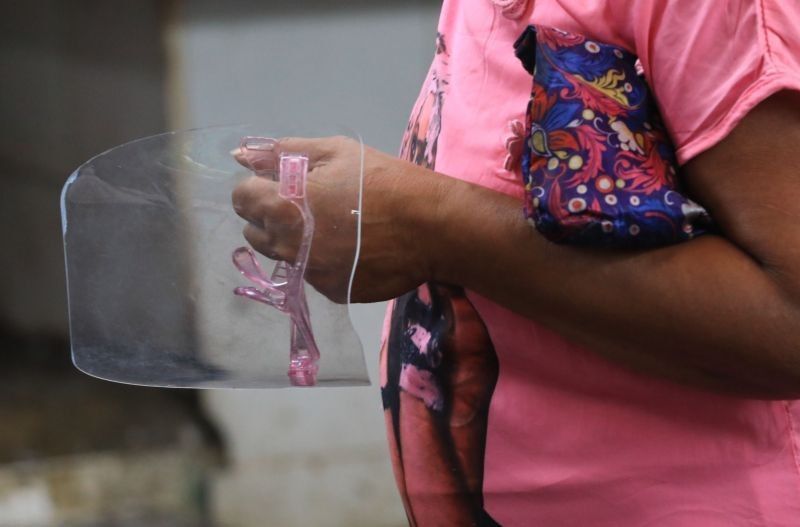#CovidisAirbornePH on Twitter: 3 things we learned from the heated thread

MANILA, Philippines — A heated Twitter exchange between a distinguished American professor of chemistry and a special adviser to the National Task Force Against COVID-19 in the Philippines about the transmission of the virus has been instructive for many netizens.
Jose-Luis Jimenez, an aerosol expert from the University of the Colorado Boulder, called out some of the country’s safety practices in an interview with ANC on January 7. Filipino physician Teodoro “Teddy” Herbosa shared a link of Jimenez’s interview on Twitter, where he questioned the latter’s validity to sound off about safety protocols.
Herbosa later found his accusations disproven.
Here are some great takeaways from the Twitter debate thread:
1. Face shields are 'outdated.'
“Face shields are outdated. At the beginning of the pandemic, we saw that when two people talk, there were some projectiles, these droplets, were flying through the air and then a face shield could intercept them,” Jimenez said in the interview.
“Now we know that’s not the case. It’s like smoke, and the smoke can go under the face shield. So face shields, basically, are useless except in a hospital,” Jimenez added.
“If someone’s gonna cough in your face… but really, what we need in a place like a hospital, since there can be transmission through the eyes and aerosols can get under the face shields, is to have some closed glasses. Like safety glasses that you may use in a laboratory or something like that,” he further said.
“And face shields are not useful, we should invest our money instead... in… masks and things that actually work,” the professor added.
2. Airborne and aerosol transmission 'are the same thing.'
Jimenez addressed Herbosa's doubts on his credibility by saying he led "a peer-reviewed paper” and demonstrating that the super spreading of COVID-19 “is due to shared-room airborne transmission."
Herbosa responded, “Airborne or aerosolized transmissions? The path (of) on bech science to clinical practice is a long route. You need to be cautious with dogmatic statements because lives are lost when the science and interpretation of evidence [are] wrong.”
Jimenez told him that airborne and aerosol transmission “are the same thing” and added that the World Health Organization “uses both terms interchangeably for both short-range and long-range.”
“I wish @WHO had considered that BEFORE they told us airborne transmission of COVID was MISINFORMATION,” the professor said.
Herbosa called Jimenez out for sharing a 2020 tweet and said that the WHO eventually accepted the virus’ aerosol transmissibility.
“Yes, after yelling at us when we met with them (@WHO and its IPC committee) on 3-Apr-2020, when we already had MORE evidence of airborne transmission than they did for large droplets or fomites,” Jimenez responded.
Herbosa responded by sharing a news article that reported the country’s low case fatality rate but Jimenez argued that a low death rate happens “after transmission.”
“I am debating what happens BEFORE transmission and the measures to avoid it,” the professor said.
3. The extensive use of lateral plexiglas (perspex) barriers in schools increases transmission.
As the two were debating, a Filipino netizen shared with Jimenez photos that show there are still barriers in motorcycle taxis.
In 2020, the government imposed that plastic barriers should be installed to separate the rider and the passenger.
“What is that? Is that in case of accident or to reduce transmission?” Jimenez asked in response to the plastic barrier rule.
“They thought putting up these barriers will reduce COVID-19 transmissions. The government here mandated motorcycle barriers, much to the protest of the Philippine Society of Mechanical Engineers,” wind engineer Joshua Agar answered Jimenez back.
“Outdoors? Ay ay ay. This belongs in [the] hall of shame,” Jimenez wrote, referencing his past thread where he tagged some countries’ ineffective measures against mitigating the virus’ transmission.
Jimenez previously called out the Philippines for implementing barriers in physical classroom setups and emphasized that the virus is airborne. He included this practice under the “World #COVIDHallofShame of worst practices” against COVID-19.
“Extensive use of lateral plexiglas (perspex) barriers in schools. They INCREASE transmission,” he tweeted before.
“Trap virus-laden air (and) make ventilation more difficult,” Jimenez added.


















